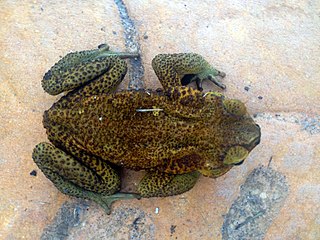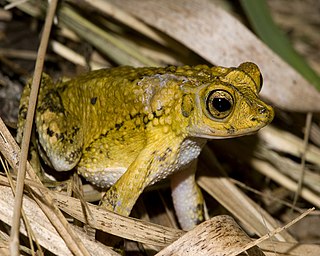Peltophryne fluviatica, also known as the Dominican Caribbean toad or Hispaniolan crestless toad, is a species of toad endemic to the Cibao Valley in the northwestern Dominican Republic. It has only been recorded at two localities.
Nectophrynoides wendyae, also known as the Uzungwe Scarp tree toad or Wendy's forest toad, is a terrestrial toad in the family Bufonidae. It is endemic to Tanzania and is only known from a single valley in the Udzungwa Mountains. The specific name wendyae honours Wendy Clarke, the describer's wife.

Duttaphrynus parietalis, commonly known as the Indian toad or ridged toad, is a species of toad found in the Western Ghats of India.

Fejervarya limnocharis is a species of frog found in South East Asia and parts of Indochina. It is known under many common names, including Boie's wart frog, rice field frog, and Asian grass frog. Molecular studies of the species complex suggest that there may be multiple species involved.

The Malabar tree toad, or warty Asian tree toad, is a species of toad found in forests along the Western Ghats of great Karnataka or Deccan. It is a small species and is found in wet tree hollows or leaf bases containing water. It is the only species in the monotypic genus Pedostibes, also known as Asian tree toads.
Ansonia malayana is a species of toad in the family Bufonidae. It is also known as Malayan slender toad, Malaya stream toad, and pigmy false toad. It is found on the Malay Peninsula, from the Kra Isthmus (Thailand) southward to Peninsular Malaysia. However, its precise distribution in Thailand is poorly known as it may have been confused with Ansonia kraensis, described as a new species in 2005; it may also represent more than one species.
Rhinella arborescandens is a species of toad in the family Bufonidae. It is endemic to Peru and only known from its type locality near Mendoza, northern Cordillera Central, in the Amazonas Region. It is unusual among Rhinella toads because it is arboreal, hence the specific name arborescandens, derived from Latin arbor for tree and scando meaning to climb.

Peltophryne guentheri, the southern crested toad or Gunther's Caribbean toad, is a species of toad in the family Bufonidae. It is endemic to Hispaniola and found in the lowlands of Haiti and the Dominican Republic.
The Cuban high-crested toad, or Gundlach's Caribbean toad, is a species of toad in the family Bufonidae that is endemic to Cuba. It is found plains in all provinces as well as Isla de la Juventud and the Sabana-Camagüey Archipelago. The specific name gundlachi honors Johannes Christoph Gundlach, a German zoologist. Its natural habitats are primarily forests but also xeric and mesic grasslands. It is an explosive breeder of rain-flooded pools. It is threatened by habitat loss and degradation caused by agriculture, and by agricultural pollution. Its habitat is also threatened by the invasive tree Dichrostachys cinerea.
The Cuban long-nosed toad, or Stejneger's Caribbean toad, is a species of toad in the family Bufonidae. It is endemic to Cuba and only known from three widely separated populations. Its natural habitats are upland pinewoods and mesic broadleaf forests. It is always found by streams. It is threatened by habitat loss caused by logging, charcoaling, fires, and agricultural expansion.

Incilius melanochlorus, formerly Bufo melanochlorus, is a mid-sized species of toad with a crested head in the family Bufonidae. It is primarily distinguished by its very long first finger with respect to the other fingers. It is found in southern Nicaragua, in the northern Cordillera Central and on the Atlantic slopes of eastern Costa Rica, and in western Panama.

Peltophryne peltocephala is a species of toad in the family Bufonidae. It is endemic to Cuba and found in central and eastern Cuba as well as on some outlying islands. It occurs in a range of habitats including broadleaf forest, grassland, savanna, and agricultural areas. It is a common species but locally threatened by habitat loss.

The Cuban spotted toad, or Cuban Caribbean toad, is a species of toad in the family Bufonidae. It is endemic to central and eastern Cuba. Its natural habitats are lowland mesic broadleaf forests, but it also occurs on cultivated fields as long as they are not too intensively farmed. It is common in suitable habitat but its distribution is severely fragmented and its habitat is threatened by intensive agriculture, charcoaling, and nickel mining.

The four-digit toad or dwarf toad is a species of toad in the family Bufonidae. It is found in Bioko, southwestern Cameroon, and southeastern Nigeria. It is the only species in the genus Didynamipus.

Xenophrys longipes is a species of frog in the family Megophryidae. It is also known as the Malacca spadefoot toad, red legged spine-eyed frog, red-legged horn frog, and slender-legged horned frog. It is found in the Malay Peninsula. Records from Cambodia and Vietnam are considered doubtful.
Ingerophrynus gollum is a toad species in the family Bufonidae, the true toads. It is endemic to the Peninsular Malaysia and has only been recorded from its type locality in the Endau-Rompin National Park, Johor. However, I. gollum is genetically so close to Ingerophrynus divergens that its validity as a distinct species can be questioned.
Ansonia jeetsukumarani is a species of toads in the family Bufonidae. It is endemic to Peninsular Malaysia and known from its type locality, Fraser's Hill, and from Sungai Pergau. It is named in honour of Jeet Sukumaran, a biologist who has worked with Malaysian amphibians.

Peltophryne is a genus of true toads in the family Bufonidae, from the Greater Antilles. With ten endemic species, Cuba hosts the highest diversity. Hispaniola has three endemics and Puerto Rico and the Virgin Islands combined has one.
Ansonia teneritas, the gracile slender toad, is a species of toad in the family Bufonidae, described in 2016. It is endemic to central Sarawak in Malaysian Borneo and is only known from two isolated mountain ridges. Its name is derived from its slender body.











